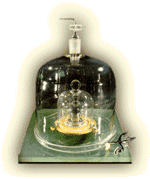Constants, Units and Uncertainties
Dead Beat, as you know, considers an appreciation of science a necessary prerequisite for any writer worth their NaCl. He has a particular interest in constants.
Indeed he will never forget his Grade 8 science teacher trying to catch a gormless student unawares by asking if the constant k ever changed. The boy nodded silently that it did amid the guffaws of all. Even then Dead Beat felt angered, not so much by the unnecessary teasing but by the notion of a fixed unspecified value. The teacher being a priest, Dead Beat thought, should have known better in every regard.
But now it seems that the nodding boy may have the last laugh.
Dead Beat reads that the international prototype for the kilogram, kept tightly under lock and key in Sevres, outside Paris is losing weight. While the rest of the world is gaining weight and turning obese, the little kilogram does it's best to lose weight as some sort of counterbalance.
A little bit of history: At the end of the 18th century, a kilogram was the mass of a cubic decimeter of water. In 1889, the 1st CGPM sanctioned the international prototype of the kilogram, made of platinum-iridium, and declared: This prototype shall henceforth be considered to be the unit of mass.
The 3d CGPM (1901), in a declaration intended to end the ambiguity in popular usage concerning the word "weight," confirmed that: The kilogram is the unit of mass; it is equal to the mass of the international prototype of the kilogram.
Along with the prototype were dozens of copies - the reference kilogram has lost 50 micrograms
compared with the average of the copies.
Has the prototype got lighter or have the copies got heavier?
And so a better difinition if needed. Something more precise than the platinum-iridium cylinder. - just as the meter which was once defined as the distance between scratches on a bar, now involves the distance that light travels in a vacuum.
The ever varying constant. The writer and his search for a measure.











No comments:
Post a Comment